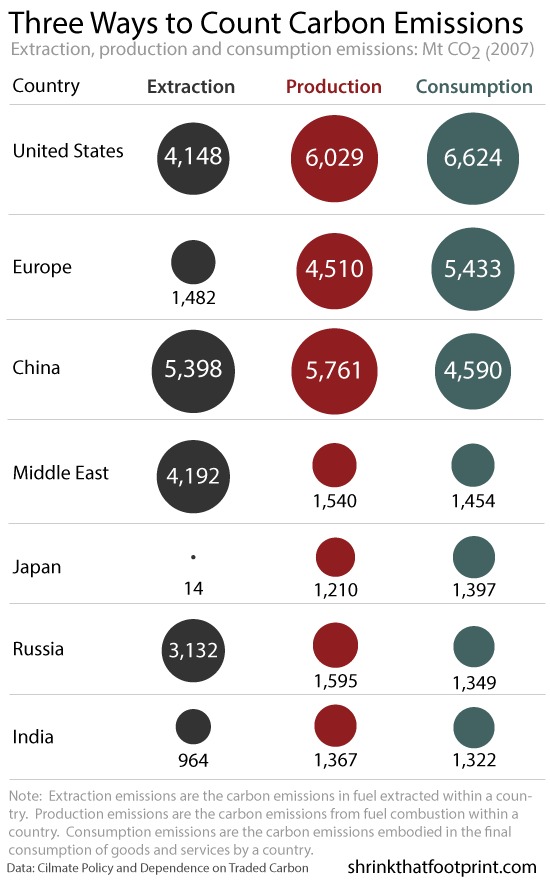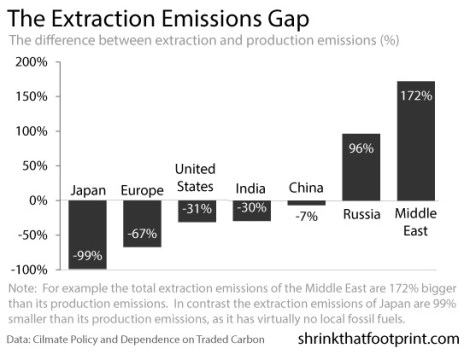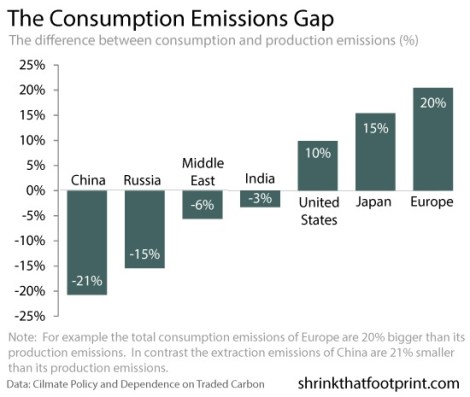If you’ve ever been on the tube in London, both the sign writer and the conductor will have reminded you to “mind the gap.” The gap in question is the one between the platform and the train. To board the train safely, you need to mind the gap. Climate policy has some fast-growing carbon gaps.
Carbon gaps are the difference between a country’s extraction, production, and consumption of fossil fuels:
- Extraction: where primary fossil fuels are extracted from the ground
- Production: where fossils fuels are combusted
- Consumption: where products made using fossil fuels are consumed
Due to the growing trade of carbon, in fuels and products, a country’s extraction emissions or consumption emissions can be very different from its production emissions (the conventional estimate). By using the three accounting points, as researchers did in the recent paper “Climate policy and dependence on traded carbon,” we can get a better understanding of a nation’s climate impact.
The graphic below details extraction, production, and consumption emission estimates for seven regions in 2007:

U.S. extraction emissions were 4,148 megatonnes (Mt) in 2007, its production emissions 6,029 Mt, and its consumption emissions 6,624 Mt. This reflects the fact it imports a lot more fossil fuel than it exports. Likewise a significant volume of products consumed in the U.S. have resulted in emissions elsewhere. In fact, 375 Mt are embodied in imports from China alone.
In China production emissions are the highest metric, reflecting the fact it is a net importer of fossil fuels, and the world’s major exporter of carbon embodied in products. For China in particular it is also worth noting that this data is from 2007, so each set of its emissions will have grown rapidly in the last five years.
The Middle East and Russia are major exporters of oil and gas. In stark contrast Japan has virtually no local fossil fuels and is completely reliant on fuel imports.
The carbon extraction gap
Because almost all the carbon emissions figures used for countries are production emissions, it is natural to compare the other accounting points to these. The gap between a country’s extraction and production emissions is what we will call the “extraction gap.”
The extraction gap is easily calculated from the image above. But it’s even more useful to ask what that gap looks like compared to the country’s production emissions, as this shows the country’s dependence on foreign fuel extraction:

The Middle East extracts 172 percent more carbon in the form of fossil fuels than it produces due to fuel combustion, reflecting its position as the world’s leading oil exporter. Russia is also a large net exporter of fuels.
On the other hand, Japan’s extraction emissions are 99 percent smaller than its production emissions, as it has virtually no viable fossil fuels. Likewise Europe is dependent on fuel imports for two-thirds of the carbon it combusts. The U.S. and India are also quite dependent on foreign fuels, though the U.S. is gradually becoming less so.
We can do a similar analysis for the consumption gap.
The carbon consumption gap
The consumption gap is the difference between a country’s consumption emissions and its productions emissions. This is the thing people are talking about when they say that Europe and the U.S. have outsourced much of their carbon intensive production to China.
Once again we’ll choose to look at the gap as a function of production emissions, as it tells us how dependent a country’s consumption is on carbon embodied in products produced elsewhere.

Europe, Japan, and the U.S. have effectively outsourced a significant volume of carbon intensive production. When you count all the emissions in the goods and services Europe consumes, it is 20 percent larger than its production emissions.
China’s consumption emissions are 21 percent smaller than its production emissions, as we might expect for the “world’s factory.”
Minding the carbon gap
If you want to board a train safely, you need to mind the gap. The same awareness is needed for climate policy.
In a world where traded carbon, both in fuels and embodied in products, is growing faster than emissions in general, nations need to be increasingly aware of carbon gaps when designing policy.
If a policy focuses on reducing a country’s extraction and consumption emissions as well as its production emissions, it will be a success. But if a policy that helps tackle local emissions results in increased exports of fuel, or outsourced carbon intensive production, it will just be shuffling emissions up and down the supply chain.




